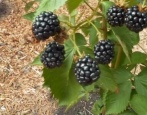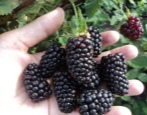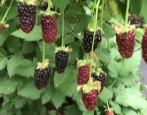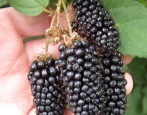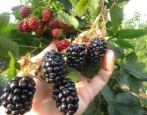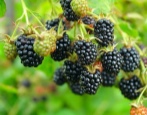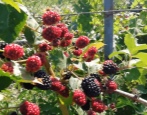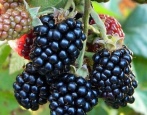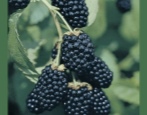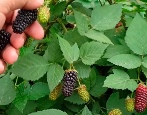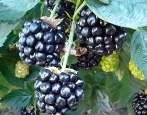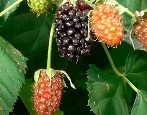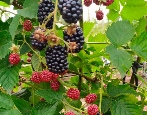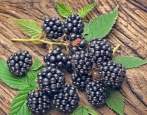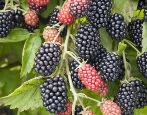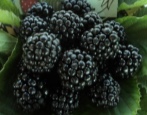
- Taste: sweet and sour
- Scent : pronounced, blackberry
- Repairability: Yes
- Berry weight, g: up to 20
- Berry size: large
- Berry color: black-purple
- Fruiting period: from July to the end of September
- Yield: 25-35 kg per bush
- Frost resistance, ° C / Winter hardiness: high, up to -30 ° С
- Watering: systematic
Many gardeners consider the Gigant variety a real find, given the many positive qualities: remontability, high yield, large fruit size and other characteristics. In Russia, blackberries are not grown as often as raspberries, but they can still be found in regions with different climatic conditions.
Breeding history of the variety
Blackberries, capable of bearing fruit several times per season, appeared relatively recently (at the turn of the 20th and 21st centuries). The work was carried out by breeders from the United States. Experts managed to develop many unusual remontant varieties. This is exactly what the fruit crop called Giant has become.
Description of the variety
You can identify a plant by spreading branches. Shoots are long, powerful, but flexible. The shrubs reach a height of 150 to 250 centimeters. Due to the flexible branches, the berries are often grown using supports. The plant can be a charming decoration for any home garden.
Ripening terms
Repaired blackberries bloom from early June to September. The fruiting season falls in July and lasts until the end of the first autumn month.
Yield
The yield indicator is high. From one shrub, they collect from 25 to 35 kilograms. Fruiting is directly dependent on plant care and favorable weather conditions.
Note: For comparison, other blackberry varieties can produce up to a maximum of 20 kilograms of fruit.
Berries and their taste
Ripe fruits turn black with a purple tint. This is the standard color for blackberries. The shape is conical and elongated, some berries can be rounded. The sizes are large. The maximum weight is 20 grams. The smell is intense, blackberry. The taste of the harvest combines sour and sweet notes. The fruits are rich in nutrients and vitamins.
Growing features
An important indicator of a good harvest is adherence to agricultural practices. The plant loves sunlight. The shrubs are watered systematically, maintaining the optimum level of soil moisture. A gap of 1-1.2 meters is left between the plants. This distance is quite enough for comfortable growth and development. Blackberries can be safely grown both in the south and in areas with a cold climate.
Site selection and soil preparation
It is believed that the Gigant berry is recommended to be planted in a carefully lit area. However, according to experienced gardeners, it is better to abandon this idea within the boundaries of the southern regions. Bright rays can burn leaves and berries. And also shrubs grow poorly in wetlands and on heavy soils. It is better to choose light and fertile lands.
For a remontant variety, soil with a neutral or weak acid reaction is ideal. Breathable soil will provide oxygen to the roots of the plant. So the shrubs will fully develop and delight with a rich harvest. The high content of limestone in the soil often provokes chlorosis (leaves begin to turn yellow).
Pruning
Before the pruning procedure, you need to decide on your goal - a large harvest at the end of summer or several waves of fruiting, which begin in June. If you choose the second option, you need to take care of protecting the shrub for the winter in advance. And also the berry must be protected from harmful insects and birds that like to feast on ripe fruits.
When choosing the first option, pruning is carried out at the end of autumn, and the root zone is covered with sawdust or dry grass.To get several waves of the harvest, of the same volume, the blackberries are not cut for the winter. The work is performed only in the second year, at the end of summer, as soon as the fruiting period ends.
Formative pruning is carried out in the fall. About 5-6 replacement shoots are left.
Note: many experienced gardeners believe that it is not worth growing remontant varieties of berries, leaving the shrubs for the winter without pruning. This procedure helps to reliably protect plants from severe frosts. And also reduce to zero disease and pest problems.
Watering and feeding
Regular and moderate irrigation is one of the main conditions for caring for a healthy and tasty berry. Repaired varieties need water to produce large and juicy fruits. It is important not to overdo it. Waterlogging will negatively affect not only the quality of the crop, but also the taste of the berries.
Nutrients also play an important role. Fertilizers are applied to the soil several times throughout the season. Complex formulations are used in the spring. With the onset of summer, they switch to phosphorus and potash fertilizers. These are the main ingredients that berries need.
Frost resistance and preparation for winter
Frost resistance of the Gigant variety is high. Blackberries can withstand frosts up to 30 degrees Celsius below zero without any problems. Despite this characteristic, on the territory of regions with harsh and long winters, it is impossible to leave the berry field without shelter. If a complete pruning has not been carried out, the shoots are removed from the supports and carefully pressed to the ground. The first layer is hay or sawdust, the second is a dense non-woven material.
Reproduction
To propagate the plantation, of which the following methods are chosen: rooting the top or the cuttings method. Such options were noted as the most effective and practical. As for the root growth, the supplier of the Gigant variety does not provide accurate information, therefore, this option is practically not used to increase the berry.


